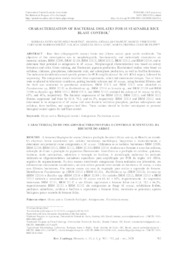Characterization of bacterial isolates for sustainable rice blast control.
Characterization of bacterial isolates for sustainable rice blast control.
Author(s): MARTINS, B. E. de M.; CHAIBUB, A. A.; CÔRTES, M. V. de C. B.; LOBO, V. L. da S.; FILIPPI, M. C. C. de
Summary: Rice blast (Magnaporthe oryzae) limits rice (Oryza sativa) grain yields worldwide. The objective of this investigation was to morphologically, biochemically, and molecularly characterize six bacterial isolates, BRM 32109, BRM 32110, BRM 32111, BRM 32112, BRM 32113, and BRM 32114, and to determine their potential as antagonists to M. oryzae. Morphological characterization was based on colony formation and color, Gram staining, and fluorescent pigment production. Biochemical studies were based on cellulase, chitinase, phosphatase, indoleacetic acid, and siderophore production, as well as biofilm formation. The molecular identification used specific primers for PCR amplification of the 16S rRNA region, followed by sequencing. The antagonism studies involved three experiments, which had randomized designs. Two of them were conducted in laboratory conditions, pairing bacterial colonies and M. oryzae, using bacterial filtrates, and the third was conducted in greenhouse conditions. BRM 32111 and BRM 32112 were identified as Pseudomonas sp., BRM 32113 as Burkholderia sp., BRM 32114 as Serratia sp., and BRM 32110 and BRM 32109 as Bacillus spp. BRM 32112, BRM 32111, and BRM 32113 inhibited the colony of M. oryzae by 68%, 65%, and 48%, respectively. The bacterial suspensions of the BRM 32111, BRM 32112, and BRM 3212 filtrates suppressed leaf blast by 81.0, 79.2, and 66.3%, respectively. BRM 32111 and BRM 32112 were determined to be antagonists of M. oryzae and were found to solubilize phosphate, produce siderophores and cellulose, form biofilms, and suppress leaf blast. These isolates should be further investigated as potential biological control agents for leaf blast control.
Publication year: 2020
Types of publication: Journal article
Unit: Embrapa Rice & Beans
Observation
Some of Embrapa's publications are published as ePub files. To read them, use or download one of the following free software options to your computer or mobile device. Android: Google Play Books; IOS: iBooks; Windows and Linux: Calibre.
Access other publications
Access the Agricultural Research Database (BDPA) to consult Embrapa's full library collection and records.
Visit Embrapa Bookstore to purchase books and other publications sold by Embrapa.

